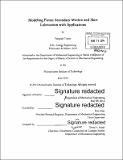| dc.contributor.advisor | Tian Tian. | en_US |
| dc.contributor.author | Totaro, Pasquale (Pasquale Pio) | en_US |
| dc.contributor.other | Massachusetts Institute of Technology. Department of Mechanical Engineering. | en_US |
| dc.date.accessioned | 2014-12-08T18:50:38Z | |
| dc.date.available | 2014-12-08T18:50:38Z | |
| dc.date.copyright | 2014 | en_US |
| dc.date.issued | 2014 | en_US |
| dc.identifier.uri | http://hdl.handle.net/1721.1/92125 | |
| dc.description | Thesis: S.M., Massachusetts Institute of Technology, Department of Mechanical Engineering, 2014. | en_US |
| dc.description | Cataloged from PDF version of thesis. | en_US |
| dc.description | Includes bibliographical references (pages 97-100). | en_US |
| dc.description.abstract | The interest in reducing emission and improving engine efficiency has become a major push in industry, due to upcoming stricter regulations. A great deal of attention has been given to the frictional losses due to piston and liner interaction, as they represent a significant portion of the total mechanical losses. This thesis work focuses on further development and application of an existing model for the piston's secondary motion and skirt lubrication. Model development has been focused on introducing liner dynamic deformation, temperature and shear-thinning effect on viscosity, and arbitrary skirt's shape definition. The theory behind the inclusion of these components is discussed and the modifications to the existing model are explained. In regards to the model's applications, an important topic is the model validation, for which friction results from simulations are compared with experimental results obtained on a floating liner engine. The analysis covers the running condition of 1000 rpm, at partial and full load. This study is, however, not concluded and more cases need to be studied in order to complete the validation of the model. The second application focuses on the effects of geometrical patterns on the skirt on friction and secondary motion of the piston. First, some regular patterns were studied and found to have negative effects on friction due to their inability to build sufficient hydrodynamic pressure, compared to the baseline design. Then, a different sets of patterns were proposed to more effectively utilize available oil and to maximize the hydrodynamic pressure generation in the skirt region. The results show that new strategy can significantly reduce friction of the skirt without introducing negative impact on the secondary motion. This thesis work aims to make the model a more complete and powerful tool to understand piston's secondary motion and the applications are meant to show the capabilities of the model, as an instrument to approach piston's design and inspire new ways and ideas to reduce frictional losses. | en_US |
| dc.description.statementofresponsibility | by Pasquale Totaro. | en_US |
| dc.format.extent | 100 pages | en_US |
| dc.language.iso | eng | en_US |
| dc.publisher | Massachusetts Institute of Technology | en_US |
| dc.rights | M.I.T. theses are protected by copyright. They may be viewed from this source for any purpose, but reproduction or distribution in any format is prohibited without written permission. See provided URL for inquiries about permission. | en_US |
| dc.rights.uri | http://dspace.mit.edu/handle/1721.1/7582 | en_US |
| dc.subject | Mechanical Engineering. | en_US |
| dc.title | Modeling piston secondary motion and skirt lubrication with applications | en_US |
| dc.type | Thesis | en_US |
| dc.description.degree | S.M. | en_US |
| dc.contributor.department | Massachusetts Institute of Technology. Department of Mechanical Engineering | |
| dc.identifier.oclc | 895894796 | en_US |
